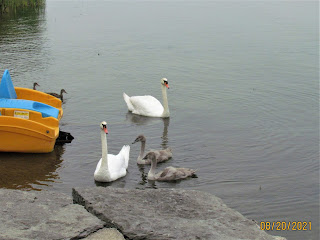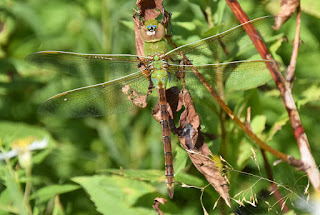NATURE MONCTON INFORMATION LINE, August 29, 2021 (Sunday)
To respond by e-mail, please address your message to the information line editor, nelsonpoirier435@gmail.com .
Please advise the editor at nelsonpoirier435@gmail.com if any
errors are noted in wording or photo labelling.
For more information on Nature Moncton, check the website at www.naturemoncton.com .
Edited by: Nelson Poirier nelsonpoirier435@gmail.com
Transcript by: Louise Nichols nicholsl@eastlink.ca
Info Line # 506-384-6397 (384-NEWS)
** For Louise Nichols, first it
was the fritillary butterflies, but Saturday, the RED ADMIRAL BUTTERFLIES
were after the Echinacea (Cone Flower).
She was seeing 4 or 5 at a time at the flowers. They were all very fresh-looking butterflies,
sometimes sharing a spot with each other or with HONEY BEES. The Cone Flower blooms late and is very
popular with butterflies, bees and hummingbirds from the reports that come in
this time of year.
Louise is also attaching a documentary photo of what she strongly
suspects is an OLIVE-SIDED FLYCATCHER.
It was a long way off on top of a tree on the other side of the
bog. The habitat is right as well as the
top-of-tree behaviour of the not-so-common Olive-sided Flycatcher.
** Jane LeBlanc got a photo of a COMMON
GREEN DARNER DRAGONFLY while picking blueberries. Jane comments they were approximately 4 in.
long and looked like near the size of hummingbirds but landed a lot less
gracefully. Gilles Belliveau comments
that the Common Green Darner is a distinctive species in our region and is
quite large and has an entirely bright green thorax. Females and immatures have a somewhat rosy to
brownish colour on the abdomen, while mature males have a bright blue colour
from the base of the abdomen that gets more brownish further back.
Jane also got photos of a COMMON
YELLOWTHROAT WARBLER from different angles.
Brian Stone sends some images
from his not so successful camping trip at Kejimkujik National Park in N.S.
with more to come the next day or two. The temperature and humidity were too
high for comfort and the first 2 days were rainy from the remnants of that
storm Henri.
His first images were of the
iconic WHITE-TAILED DEER that populate the roadside throughout the park.
First was a family unit of 4; 2 adults and 2 fawns. No problem getting
those images as the deer don't seem to mind close photography. Further along
the road one was slowly crossing in front of his car. Around his campsite and
some park destinations EASTERN WOOD PEEWEES were common and very vocal,
as was a WHITE-BREASTED NUTHATCH. The CAROLINA GRASSHOPPERS were
a much lighter, tan colour than the ones he has noted around Moncton. Only 2 PAINTED
TURTLES were seen resting on a log with the rest of them possibly cooling
deep in the pond water.
A COMMON RINGLET BUTTERFLY
seemed a deeper colour than the local versions in NB and some interesting plants
and fungus were photographed that might need further identification.
Brian also got a huge FUNNEL WEB SPIDER running across
the bedroom floor just before he headed out camping on Sunday, Aug. 22. It was
2 cm body length and 5 to 6 cm leg span. A monster he comments!
**Aldo Dorio got a photo of an OVENBIRD at Hay Island
on Sunday morning that shows its russet crown bordered by dark stripes , bold
white eye ring, and bold breast streaking.
** Lois Budd shares photos of a family of MUTE SWANS and their almost-grown cygnets that she enjoyed some swimming time with on Hay Bay in Ontario. A cottage friend feeds them some cracked corn, and they have been bringing their young all summer to his beach. There are about 35 more along the marsh area of Hay Bay, but only this family was friendly. You can see the white feathers starting on the cygnets, and Lois was taken by the beautiful way the male is spreading his wings in one photo as it swam. They are very laid-back birds, but she kept her distance of about 8 feet while swimming near them. She comments that it was quite an experience. Mute Swans are known to be potentially aggressive if indicated or they think it is. This family seems very comfortable around humans.
**A heads-up on the last of the
successful Tuesday night Nature Moncton outings coming up this coming
Tuesday night, August 31. All details attached below:
Tuesday
Evening Outing. August 31., 2021
This week’s
outing will be the last of this season. We hope you have enjoyed them and would
be interested in hearing suggestions for improvements and possible locations
for next year.
We will be
meeting at 31 Rockland No. 1 Road, Taylor Village (instructions to follow) to
start a walk at 6:30 PM. We will begin
the walk through an area that nature is working at reclaiming then follow along
the Memramcook River for about a kilometer to a Ducks Unlimited Pond. The
walking surface will be mostly grass or an old roadway. Some of the things we may see include
Aboiteau, dykes, a wide range of flora, various hawks, Bald eagles, Shore
birds, Marsh birds and ducks, Muskrat, Mink, Weasel, Beaver, White tailed deer
and a million or so small birds. We hope you can make it.
To get to
the event ….. https://goo.gl/maps/tLLMVBBzvG2a1KJ7A
Moncton
NB
From Main St/NB-106 E
Continue
to follow NB-106 E
1.8 km
Slight right onto Acadie Ave/NB-106
E
Continue
to follow NB-106 E
18.2 km
Turn right onto Central St
3.1 km
Just past the
Irving
Stay left on Central St
4.6 km
Turn left onto Rockland No1 Rd
Destination
will be on the left
950 m
31 Rockland No1 Rd
Taylor Village, NB E4K 2R1
Nelson Poirier,
Nature Moncton


























